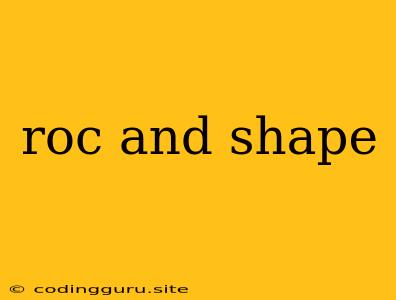The Power of ROC Curves: Understanding and Utilizing Them for Optimal Shape Analysis
In the realm of machine learning and data analysis, understanding and interpreting model performance is paramount. ROC (Receiver Operating Characteristic) curves are a crucial tool for evaluating the effectiveness of binary classification models. They offer a comprehensive view of a model's ability to distinguish between different classes, particularly when dealing with shapes and their characteristics.
What is a ROC Curve?
A ROC curve is a graphical representation of a classification model's performance across various threshold values. It plots the true positive rate (TPR), also known as sensitivity, against the false positive rate (FPR), also known as 1 - specificity.
- True Positive Rate (TPR): The proportion of correctly classified positive instances (correctly identified shapes belonging to a specific class).
- False Positive Rate (FPR): The proportion of incorrectly classified negative instances (shapes incorrectly labeled as belonging to the specific class).
ROC curves are valuable because they provide insights into how well a model can differentiate between classes while adjusting the threshold for classification.
How to Interpret a ROC Curve:
- The Ideal ROC Curve: The ideal ROC curve would hug the top-left corner of the graph. This indicates a perfect model, achieving a high TPR with minimal FPR.
- The Diagonal Line: A diagonal line from the bottom-left to the top-right corner represents a random classifier with no predictive power.
- Area Under the Curve (AUC): The area under the ROC curve (AUC) is a key metric for summarizing a model's overall performance. A higher AUC indicates better classification accuracy.
ROC Curves and Shape Analysis:
ROC curves are particularly useful for analyzing shapes in various applications:
- Image Classification: When classifying images containing different shapes, ROC curves help determine the model's ability to distinguish between, for example, circles, squares, and triangles.
- Object Detection: In object detection tasks, ROC curves are essential for evaluating the accuracy of detecting specific shapes within images, such as identifying cars, pedestrians, or buildings.
- Medical Imaging: ROC curves are crucial for assessing the performance of models analyzing medical images. For example, in radiology, they can evaluate the ability to detect tumors or other abnormalities based on their shapes.
- Geometric Analysis: ROC curves can also be used to analyze the effectiveness of models in recognizing and classifying various geometric shapes based on their properties like area, perimeter, and angles.
Using ROC Curves to Optimize Model Performance:
- Threshold Selection: ROC curves allow you to choose the optimal threshold value that balances between minimizing false positives and maximizing true positives.
- Model Comparison: Comparing ROC curves of different models helps determine which one performs best for your specific shape analysis task.
- Feature Importance: By observing how the ROC curve changes when including or excluding specific features, you can determine their importance for classifying shapes.
Example:
Let's consider a scenario where you are building a model to identify different types of shapes (circle, square, triangle) from images. You would train the model on a dataset of labeled images and then plot the ROC curves for each shape class. By examining the AUC and the ROC curve's shape, you can evaluate the model's ability to distinguish between the different shapes. If the AUC is high and the curve hugs the top-left corner, it suggests your model effectively discriminates between the shapes.
Conclusion:
ROC curves are an invaluable tool for understanding and optimizing the performance of binary classification models, especially when analyzing shapes. They provide a comprehensive view of model accuracy, facilitate threshold selection, and enable comparisons between models. By utilizing ROC curves, you can gain a deeper understanding of your model's strengths and weaknesses and achieve more accurate shape analysis results.
